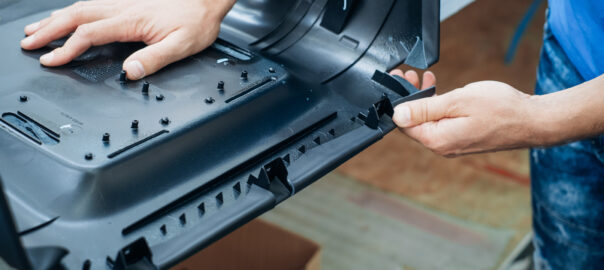Thermoforming is a highly versatile and efficient manufacturing process used to create a variety of plastic parts by heating a plastic sheet until it’s pliable and then molding it into a desired shape. This process can be tailored to produce both small and large parts with varying levels of detail. Thermoforming is widely used across industries such as automotive, aerospace, medical, and packaging, particularly for large parts and low-to-mid volume production thermoforming . However, there are specific instances where thermoforming shines, as well as cases where it may not be the ideal choice.
1. When Thermoforming Is Best Suited
a. Large Parts with Simple Geometries:
Thermoforming is ideal for large, simple parts that don’t require intricate detailing. Items such as vehicle body panels, trays, plastic pallets, and signage are often produced using . It allows for the creation of large parts at a lower cost compared to processes like injection molding, where molds for larger parts are more expensive.
b. Heavy-Gauge Thermoforming for Large, Durable Parts:
In heavy/thick-gauge thermoforming, plastic sheets thicker than 1/16 inch (1.5 mm) are used to create robust, durable parts. This process is commonly used for larger applications such as automotive body panels, appliance housings, or interior panels for recreational vehicles (RVs). Heavy-gauge thermoforming allows for the creation of structurally strong parts that can withstand higher levels of impact and wear.
c. Thin-Gauge Thermoforming for Lightweight, Disposable Parts:
In contrast, light/thin-gauge thermoforming uses plastic sheets thinner than 1/16 inch (1.5 mm) to produce lightweight parts, typically for disposable or single-use applications. This process is widely used in the packaging industry to create items such as blister packs, clamshell packaging, and trays for food or medical devices. Thin-gauge thermoforming is cost-effective for packaging and other industries where weight reduction and material savings are key concerns.
d. Low-to-Mid Volume Production:
Thermoforming is particularly cost-effective for low-to-mid volume production, with tooling costs being much lower than injection molding. This makes it an ideal choice for businesses that need anywhere from a few hundred to several thousand units. Additionally, for products that require customization or frequent design changes, thermoforming tooling can be quickly and affordably modified.
e. Prototyping and Customization:
Due to its flexibility and lower tooling costs, is perfect for prototyping and rapid design iterations. If you need to test different versions of a product before committing to large-scale production, offers a fast and cost-effective solution. Whether you’re prototyping an automotive part or testing packaging for a medical device, thermoforming allows for easy modifications to the design.
f. Cost-Effective for Packaging Solutions:
Thermoforming is widely used in the packaging industry, especially for creating rigid, transparent containers that allow consumers to see the product inside. Blister packs, clamshell packaging, and trays for electronics, food, and medical devices are commonly produced using. It offers a balance between cost-efficiency and protection, making it ideal for packaging fragile or high-value items.
2. When Thermoforming May Not Be the Best Option
While thermoforming is a versatile and efficient process, it has some limitations where other manufacturing methods might be more appropriate.
a. Highly Complex Geometries and Precision Needs:
Thermoforming has limitations when it comes to creating parts with highly intricate designs or extreme precision. Parts with undercuts, fine details, or tight tolerances may not be feasible. In such cases, injection molding is a better alternative, as it can handle more complex geometries with higher precision.
b. Limited Material Options and Durability:
While thermoforming can work with a variety of thermoplastics, it may not offer the level of material strength or heat resistance required for certain applications. For parts exposed to extreme temperatures or requiring high mechanical strength, fiberglass FRP or metal fabrication (using materials such as aluminum or steel) may be better suited.
c. Structural Integrity and Thickness Limitations:
Though heavy-gauge thermoforming produces durable parts, it may not be suitable for applications requiring extremely high structural integrity or thickness. For parts that need greater strength or load-bearing capacity, alternative methods like fiberglass RTM or metal fabrication might offer better performance. For example, parts like boat hulls or heavy-duty industrial components benefit more from these alternative processes.
d. Low Precision or Surface Finish Requirements:
For parts that require high surface quality or tight tolerances, injection molding or Resin Transfer Molding (RTM) may be better options. Thermoformed parts often lack the surface precision required for applications like high-end consumer electronics or aerospace components, where exact surface finishes are critical.
Conclusion
Thermoforming is a highly effective manufacturing process when large, simple parts or lightweight packaging solutions are required. Heavy-gauge thermoforming is ideal for durable, large components in industries like automotive, while thin-gauge thermoforming excels in packaging and disposable products. However, for complex designs, high precision, or parts requiring more strength and durability, alternative methods like injection molding, fiberglass FRP, or metal fabrication may be more suitable.
Om Raj Tech, through its representation of STM Plastics, offers custom thermoforming solutions for both heavy and thin-gauge applications. Whether you’re looking to produce large, durable parts or lightweight packaging, we can tailor our services to meet your specific project needs.
Contact us to explore how we can bring your designs to life with cost-effective and high-quality solutions.



